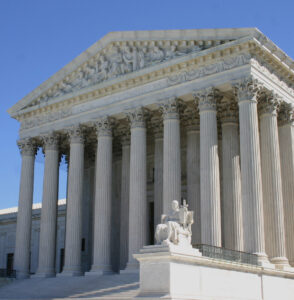First published by Safety+Health an NSC publication
 Washington — Who gets to decide how to protect workers against COVID-19? That was one of the central questions posed by opponents of OSHA’s emergency temporary standard on COVID-19 vaccination, testing and masking during a Jan. 7 hearing before the U.S. Supreme Court.
Washington — Who gets to decide how to protect workers against COVID-19? That was one of the central questions posed by opponents of OSHA’s emergency temporary standard on COVID-19 vaccination, testing and masking during a Jan. 7 hearing before the U.S. Supreme Court.
Scott Keller, attorney for the National Federation of Independent Business, presented the question in a response to questioning from Justice Stephen Breyer early in the two-hour hearing. “You said the question is, ‘Who decides?’” Justice Elena Kagan said to Keller later in the hearing. “I think that’s right. I think that is the question.”
Kagan contended in her questioning that OSHA has experts on workplace safety and is politically accountable to the public via the election of presidents and representatives in Congress.
“Courts are not politically accountable,” she said. “Courts have not been elected. Courts have no epidemiological expertise. Why in the world would courts decide this question?”
Keller and Ohio Solicitor General Benjamin Flowers contended that Congress didn’t give OSHA clear authority to address vaccinations in the Occupational Safety and Health Act of 1970. The duo also argued that states and private businesses can decide how to protect workers from COVID-19.
Chief Justice John Roberts expressed similar thoughts to U.S. Solicitor General Elizabeth Prelogar, who was arguing on behalf of the government.
“It sounds like the sort of thing that states will be responding to, or should be, and Congress should be responding to, rather than agency by agency of the federal government and the executive branch acting alone.”
Justice Sonia Sotomayor mentioned that “certain states … are stopping employers from requiring vaccines” and masks.
“Why shouldn’t the federal government, which … Congress has decided to give OSHA the power to regulate workplace safety, have a national rule that will protect workers?” she asked.
Reading from the OSH Act, Sotomayor noted that Congress gave OSHA the authority to develop “innovative methods, techniques and approaches for dealing with occupational health and safety problems.”
Prelogar pointed to Section 20(a)(5), which reads: “Nothing in this or any other provision of this act shall be deemed to authorize or require medical examination, immunization, or treatment for those who object thereto on religious grounds, except where such is necessary for the protection of the health or safety of others.”


